William Henry E-6 Review
This review sample was provided by KnifeArt.
NOTE: Before I start the review itself, its probably necessary for me to do a little disclaimer, not unlike the ones I did before the Strider PT review and the Maxpedition Pygmy Falcon II review. Unlike those disclaimers regarding bad behavior of a brand, this one involves me.
A few years ago a web person for William Henry asked me to remove all of the links I posted on this site to their site. I agreed on one condition: that someone from William Henry explain why and allow me to post that explanation, unedited, on the site. Naturally, they declined.
This is kind of request is common (though not in the Gear World). SEO folks don't like these stray links and ones that link to pages that are critical of a brand are not liked by marketing folks. I get why they did it, but I am not about to have a company censor what I say without an explanation to folks that they are doing this. I knew, of course, that they would never agree to write the response, so by offering I was, in fact, saying no. And if they had enough guts to write it, well, I would have held up my end of the bargain, but I was confident they wouldn't accept the deal.
If this was all that happened, I would leave it alone and not mention it. But a few months after that they contacted me again and again wanted to talk about the links. This time they were a bit more aggressive, not threatening, but using language that sounded vaguely legal (I don't recall the exact words but it was a silly attempt to use legalese). Meh, that stuff doesn't work on me, try someone else. Naturally, I repeated my offer and naturally they declined.
In my 6 plus years of running this blog this is the only company to reach out like that to me. When I was critical of a KAI product Thomas W hopped on the site and argued back. That is a company that puts its money where its mouth is--they are willing to discuss a review and defend their position and dispute my conclusions. That is something that earns respect in my eyes. What William Herny did does not. It earns enmity.
So that's the bad behavior report.
Here is the second thing--I am pretty clearly biased against William Henry's aesthetic. Railing on their most ostentatious designs is practically a recurring segment on the podcast, but when you make knives like this and sell them for $50,000 or charge people $1,000 for what is essentially a fancy tube with a cheap pen kit inside, I am not going to be thrilled. When you add to that line up actual bro jewelry, well, its safe to say I am a bit more than biased against William Henry.
This is all very important for you to know because, if anything, it means I am predisposed to dislike the E-6. But the reality is this is truly excellent knife. With two slight changes it would be among the best gentleman's EDC blades out there. It is also proof that Matt Conable, for all of his hype for the brand and...well...the bro jewelry, is actually one hell of a knife maker and designer.
Here is the product page. It is listed as out of stock on their page. It may be that they are phasing out the E series or that they are just between production runs. I don't know. The William Henry E-6 costs $300. There are a variety of inlays, carbon fiber, box elder, and cocobolo, all coming in at the same price (Chris Reeve, take note of that please...). There are no written reviews of this knife, which is shocking given its price tag and William Henry's visibility in the market. Here is a thread on Bladeforums about the knife. Here is a video review. Here is a link to Knife Art, where you can find the E-6.
Here is my review sample:
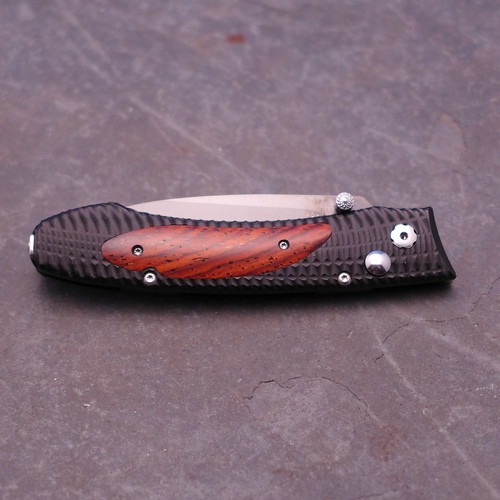
Twitter Review Summary: A few nits to pick, but otherwise, totally underrated.
Design: 2
At one point in the early 2000s the Minnesota Twins got to the playoffs year after year without spending a lot of money. They were widely regarded as being one of the most fundamentally sound baseball teams of all time. They made no mistakes. They ran the bases with speed if they had it and if they didn't they ran them smartly. They hit and were cognizant of the strike zone and the runners on base. They played airtight but boring defense (except for Torii Hunter--he is one of my favorite players of all time because of plays like these, check time index 5:40 and remember he is older than I am when he made that play). William Henry designs are like that, if all of the Twins were wearing outfits from Liberace's closet the entire game.
Peel away that hideous pirate engraving or the eagle or the lion or whatever else adorns the vast majority of William Henry blades and you will find, at core, a very solid and fundamentally good knife design.
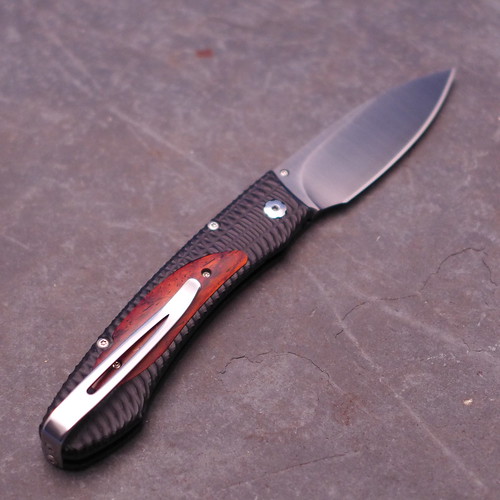
The performance ratios are good, very good. The blade:weight is 2.75. The blade:handle is .79. The ratios are very close to the top of the range for both.
Fit and Finish: 1
Two things result in a less than perfect score: 1) the blade finish; and 2) the clumsy inlay. Both are non-functional issues but on a knife this expensive and in this particular role, you deserve better.
When the original E-6 came out and was a D2 blade I get the need for a coating. D2 is not stainless steel and tends to tarnish easily. A DLC coating really helps with that. Unfortunately the DLC coating here is a powerful dirt magnet. Even freshly washed hands caused fingerprints. There was literally no way to handle the blade without causing some smudge or streak. And when handling really acidic chores, like slicing certain foods, the finish got very, very streaky. Only a good thorough cleaning got rid of the problem. And the irony is that now with M390 as the blade steel, the coating is 100% unnecessary. So you get to this point--you have a coating to prevent marks on the blade that causes marks on the blade when the blade no longer needs a coating. Also, I think the knife would look nicer with a satin finish, matching the clip and giving the E-6 a very balanced appearance.
The inlay is a more fundamental problem.
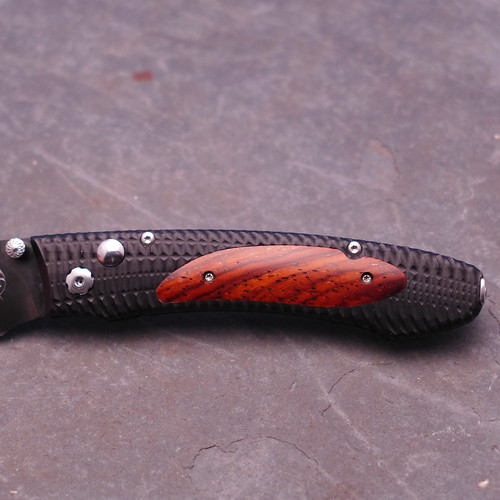
There is a noticeable lip around the edge where the inlay doesn't match the aluminum perfectly. Its not huge but definitely big enough to feel. Second, the two tiny screws are pretty garish, breaking up a perfectly nice piece of cocobolo for no real reason. William Henry could quite easily attach the inlays from the inside, using a hidden screw technique like what is found on the Millit Knives-made TAD Dauntless Mk. IV. All of this is criticism that can be leveled against the E-6 without reference to the biggest problem vis a vis the inlay--the Mnandi. The Mnandi's inlay is much better, much cleaner, and frankly a stunning achievement in knife making on a production scale. By comparison the E-6's inlay is pretty poorly implemented.
Again, none of these things are functional problems, but in this rarified air its fair to be extra picky. One clever solution would be to skip the application of the DLC coating and its associated finishing and take that time and money and invest it in an extra step to make the inlay attach via internal hidden screws. These steps may not be the same in terms of time or money, but both would make the E-6 a substantially better knife.
Grip: 1
There is a machinist at William Henry that made the handle pattern and he was really thrilled to be playing with a new CNC machine, so he cut and cut and cut. Pass after pass the grip took shape and it wasn't so harsh. At the very end of the process he just went a little too far and made the tail end of the knife almost rasp sharp. Its unpleasant, like a dirty or torn contact--always annoying and sometimes downright painful.
Carry: 2
The knife is slim, weighs an ounce, and is about as wide as your finger. It couldn't possibly carry any better, especially with a deep carry clip. Every single thing about the E-6 makes it great in the pocket.
Steel: 2
D2 is definitely below par for $300 (that makes it insulting at $600...yes Medford I am looking at you). M390, on the other hand, is a great steel at $300. I have said this before, but M390 is one of my favorites and the little fake out proved its an upgrade. I could actually tell it wasn't D2. I am not Cliff Stamp. I am not a metallurgist. But I have a good sample of steels to pull on and I could tell this blade was keener and didn't tarnish as much. When I found out it was M390 things clicked in to place. And that is the best complement I could pay a steel--its good enough to have noticeable effects in the real world and not just on a spec sheet and MSRP.
Blade Shape: 2
I love this spearpoint-ish blade shape--lots of belly, a decent point, and non-threatening.
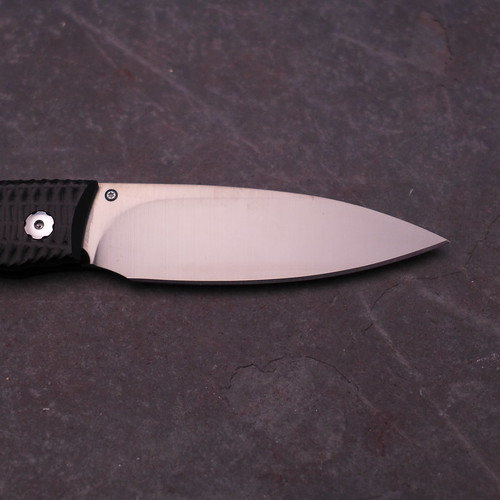
Its funny to say, but this blade shape is identical to the blade shape on the Techno, albeit on a blade three times thinner. High utility and good looks. Love it.
Grind: 2
Phew, now this is a grind. The edge was so thin, so perfectly slicey that I was passing through food as if it were fog. Grapes split apart as if they were separated by telekinesis and apples were diced to a degree befitting a master chef. This grind was just a hair behind the insanity that is the Le Francaise from Perceval. But for that blade, this would easily be the best grind I have seen on a production knife.
Deployment Method: 2
Oh man, this the "trick" of this knife. The blade flies out of the handle with authority thanks to a silken pivot, a great detent, and a very good thumb stud (which does seem to be reversible). The action is addictive and crushes the CRK Mnandi, this knife's chief competition. Of all the parts of the knife I like this is the one that demonstrates to me Conable's skill, the detent on the button lock, which typical don't have detents, is superb. Excellent job.
Retention Method: 2
Clip's great, I just wish it matched the blade. Its a small thing and one not worth a point, but just make this in a satin finish blade and leave the clip as is and it will be perfect.
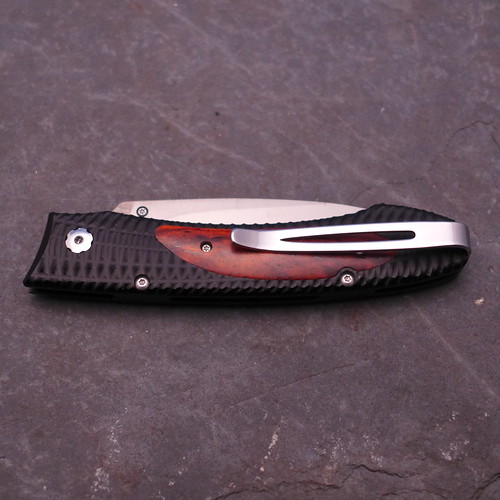
Lock: 2
The lock was stable, easy to engage and disengage, and the finish version of a button lock I have seen. AG Russell credits Conable with essentially overhauling the button lock and having used one before I can see why the improvements are big deal. The Conable designed button lock might be one of my two or three locks in the knife world. Very, very good stuff. Take the superior performance as a lock and add to it the awesome detent and you have a true engineering feat.
Overall Score: 18 out of 20
The E-6 is awesome. It makes William Henry's decent into the HumVee world of bro accoutrements even sadder. Why make bracelets with skull links and rubies for eyes when you can do this? Alas the reasons is probably simple--the margins on bro jewelry are probably staggering.
In the end the E-6 is a great knife, a knife that I would happily carry for a very long time with little consideration of alternatives. Think of it as a lighter, nicer Benchmade Valet--the size, thumb studs, and action are very, very similar, but the E-6 has that extra bit of polish and some ineffable quality that makes it better than the Benchmade.
If you were on the fence about whether to buy the E-6, buy with confidence--this is a truly superior piece of cutlery and makes for a sublime EDC. Ignore the coating and its dirt magnetism...the action is killer and the grind is amazing. Pay no attention to the brand shenanigans and requests to take down links.
The Competition
All of this is great but for one thing--the Chris Reeve Mnandi. The Mnandi and the E-6 are probably as close as competitors get--even more similar than, say the Mini Grip and the Delica. With the upgraded steel on the E-6 these knives are just so close. In the end, the Mnandi is a better knife, though it is much closer than I originally thought. With the upgraded steel and the Mnandi's downgraded deployment method I think it is close enough to say that preference should decide. The Mnandi's overall design, its stunning pocket clip and perfect inlay puts, it ahead of the E-6 in my eyes, but I wouldn't disagree with you if you saw it the other way. If the coating on the blade goes away, the E-6 might edge out the Mnandi.
NOTE: Before I start the review itself, its probably necessary for me to do a little disclaimer, not unlike the ones I did before the Strider PT review and the Maxpedition Pygmy Falcon II review. Unlike those disclaimers regarding bad behavior of a brand, this one involves me.
A few years ago a web person for William Henry asked me to remove all of the links I posted on this site to their site. I agreed on one condition: that someone from William Henry explain why and allow me to post that explanation, unedited, on the site. Naturally, they declined.
This is kind of request is common (though not in the Gear World). SEO folks don't like these stray links and ones that link to pages that are critical of a brand are not liked by marketing folks. I get why they did it, but I am not about to have a company censor what I say without an explanation to folks that they are doing this. I knew, of course, that they would never agree to write the response, so by offering I was, in fact, saying no. And if they had enough guts to write it, well, I would have held up my end of the bargain, but I was confident they wouldn't accept the deal.
If this was all that happened, I would leave it alone and not mention it. But a few months after that they contacted me again and again wanted to talk about the links. This time they were a bit more aggressive, not threatening, but using language that sounded vaguely legal (I don't recall the exact words but it was a silly attempt to use legalese). Meh, that stuff doesn't work on me, try someone else. Naturally, I repeated my offer and naturally they declined.
In my 6 plus years of running this blog this is the only company to reach out like that to me. When I was critical of a KAI product Thomas W hopped on the site and argued back. That is a company that puts its money where its mouth is--they are willing to discuss a review and defend their position and dispute my conclusions. That is something that earns respect in my eyes. What William Herny did does not. It earns enmity.
So that's the bad behavior report.
Here is the second thing--I am pretty clearly biased against William Henry's aesthetic. Railing on their most ostentatious designs is practically a recurring segment on the podcast, but when you make knives like this and sell them for $50,000 or charge people $1,000 for what is essentially a fancy tube with a cheap pen kit inside, I am not going to be thrilled. When you add to that line up actual bro jewelry, well, its safe to say I am a bit more than biased against William Henry.
This is all very important for you to know because, if anything, it means I am predisposed to dislike the E-6. But the reality is this is truly excellent knife. With two slight changes it would be among the best gentleman's EDC blades out there. It is also proof that Matt Conable, for all of his hype for the brand and...well...the bro jewelry, is actually one hell of a knife maker and designer.
Here is the product page. It is listed as out of stock on their page. It may be that they are phasing out the E series or that they are just between production runs. I don't know. The William Henry E-6 costs $300. There are a variety of inlays, carbon fiber, box elder, and cocobolo, all coming in at the same price (Chris Reeve, take note of that please...). There are no written reviews of this knife, which is shocking given its price tag and William Henry's visibility in the market. Here is a thread on Bladeforums about the knife. Here is a video review. Here is a link to Knife Art, where you can find the E-6.
Here is my review sample:

Twitter Review Summary: A few nits to pick, but otherwise, totally underrated.
Design: 2
At one point in the early 2000s the Minnesota Twins got to the playoffs year after year without spending a lot of money. They were widely regarded as being one of the most fundamentally sound baseball teams of all time. They made no mistakes. They ran the bases with speed if they had it and if they didn't they ran them smartly. They hit and were cognizant of the strike zone and the runners on base. They played airtight but boring defense (except for Torii Hunter--he is one of my favorite players of all time because of plays like these, check time index 5:40 and remember he is older than I am when he made that play). William Henry designs are like that, if all of the Twins were wearing outfits from Liberace's closet the entire game.
Peel away that hideous pirate engraving or the eagle or the lion or whatever else adorns the vast majority of William Henry blades and you will find, at core, a very solid and fundamentally good knife design.

The performance ratios are good, very good. The blade:weight is 2.75. The blade:handle is .79. The ratios are very close to the top of the range for both.
Fit and Finish: 1
Two things result in a less than perfect score: 1) the blade finish; and 2) the clumsy inlay. Both are non-functional issues but on a knife this expensive and in this particular role, you deserve better.
When the original E-6 came out and was a D2 blade I get the need for a coating. D2 is not stainless steel and tends to tarnish easily. A DLC coating really helps with that. Unfortunately the DLC coating here is a powerful dirt magnet. Even freshly washed hands caused fingerprints. There was literally no way to handle the blade without causing some smudge or streak. And when handling really acidic chores, like slicing certain foods, the finish got very, very streaky. Only a good thorough cleaning got rid of the problem. And the irony is that now with M390 as the blade steel, the coating is 100% unnecessary. So you get to this point--you have a coating to prevent marks on the blade that causes marks on the blade when the blade no longer needs a coating. Also, I think the knife would look nicer with a satin finish, matching the clip and giving the E-6 a very balanced appearance.
The inlay is a more fundamental problem.

There is a noticeable lip around the edge where the inlay doesn't match the aluminum perfectly. Its not huge but definitely big enough to feel. Second, the two tiny screws are pretty garish, breaking up a perfectly nice piece of cocobolo for no real reason. William Henry could quite easily attach the inlays from the inside, using a hidden screw technique like what is found on the Millit Knives-made TAD Dauntless Mk. IV. All of this is criticism that can be leveled against the E-6 without reference to the biggest problem vis a vis the inlay--the Mnandi. The Mnandi's inlay is much better, much cleaner, and frankly a stunning achievement in knife making on a production scale. By comparison the E-6's inlay is pretty poorly implemented.
Again, none of these things are functional problems, but in this rarified air its fair to be extra picky. One clever solution would be to skip the application of the DLC coating and its associated finishing and take that time and money and invest it in an extra step to make the inlay attach via internal hidden screws. These steps may not be the same in terms of time or money, but both would make the E-6 a substantially better knife.
Grip: 1
There is a machinist at William Henry that made the handle pattern and he was really thrilled to be playing with a new CNC machine, so he cut and cut and cut. Pass after pass the grip took shape and it wasn't so harsh. At the very end of the process he just went a little too far and made the tail end of the knife almost rasp sharp. Its unpleasant, like a dirty or torn contact--always annoying and sometimes downright painful.
Carry: 2
The knife is slim, weighs an ounce, and is about as wide as your finger. It couldn't possibly carry any better, especially with a deep carry clip. Every single thing about the E-6 makes it great in the pocket.
Steel: 2
D2 is definitely below par for $300 (that makes it insulting at $600...yes Medford I am looking at you). M390, on the other hand, is a great steel at $300. I have said this before, but M390 is one of my favorites and the little fake out proved its an upgrade. I could actually tell it wasn't D2. I am not Cliff Stamp. I am not a metallurgist. But I have a good sample of steels to pull on and I could tell this blade was keener and didn't tarnish as much. When I found out it was M390 things clicked in to place. And that is the best complement I could pay a steel--its good enough to have noticeable effects in the real world and not just on a spec sheet and MSRP.
Blade Shape: 2
I love this spearpoint-ish blade shape--lots of belly, a decent point, and non-threatening.

Its funny to say, but this blade shape is identical to the blade shape on the Techno, albeit on a blade three times thinner. High utility and good looks. Love it.
Grind: 2
Phew, now this is a grind. The edge was so thin, so perfectly slicey that I was passing through food as if it were fog. Grapes split apart as if they were separated by telekinesis and apples were diced to a degree befitting a master chef. This grind was just a hair behind the insanity that is the Le Francaise from Perceval. But for that blade, this would easily be the best grind I have seen on a production knife.
Deployment Method: 2
Oh man, this the "trick" of this knife. The blade flies out of the handle with authority thanks to a silken pivot, a great detent, and a very good thumb stud (which does seem to be reversible). The action is addictive and crushes the CRK Mnandi, this knife's chief competition. Of all the parts of the knife I like this is the one that demonstrates to me Conable's skill, the detent on the button lock, which typical don't have detents, is superb. Excellent job.
Retention Method: 2
Clip's great, I just wish it matched the blade. Its a small thing and one not worth a point, but just make this in a satin finish blade and leave the clip as is and it will be perfect.

Lock: 2
The lock was stable, easy to engage and disengage, and the finish version of a button lock I have seen. AG Russell credits Conable with essentially overhauling the button lock and having used one before I can see why the improvements are big deal. The Conable designed button lock might be one of my two or three locks in the knife world. Very, very good stuff. Take the superior performance as a lock and add to it the awesome detent and you have a true engineering feat.
Overall Score: 18 out of 20
The E-6 is awesome. It makes William Henry's decent into the HumVee world of bro accoutrements even sadder. Why make bracelets with skull links and rubies for eyes when you can do this? Alas the reasons is probably simple--the margins on bro jewelry are probably staggering.
In the end the E-6 is a great knife, a knife that I would happily carry for a very long time with little consideration of alternatives. Think of it as a lighter, nicer Benchmade Valet--the size, thumb studs, and action are very, very similar, but the E-6 has that extra bit of polish and some ineffable quality that makes it better than the Benchmade.
If you were on the fence about whether to buy the E-6, buy with confidence--this is a truly superior piece of cutlery and makes for a sublime EDC. Ignore the coating and its dirt magnetism...the action is killer and the grind is amazing. Pay no attention to the brand shenanigans and requests to take down links.
The Competition
All of this is great but for one thing--the Chris Reeve Mnandi. The Mnandi and the E-6 are probably as close as competitors get--even more similar than, say the Mini Grip and the Delica. With the upgraded steel on the E-6 these knives are just so close. In the end, the Mnandi is a better knife, though it is much closer than I originally thought. With the upgraded steel and the Mnandi's downgraded deployment method I think it is close enough to say that preference should decide. The Mnandi's overall design, its stunning pocket clip and perfect inlay puts, it ahead of the E-6 in my eyes, but I wouldn't disagree with you if you saw it the other way. If the coating on the blade goes away, the E-6 might edge out the Mnandi.
